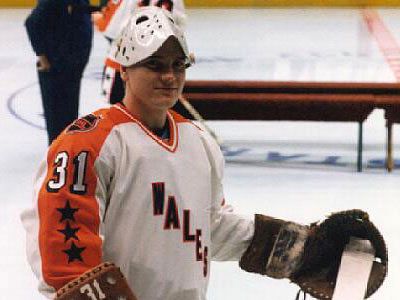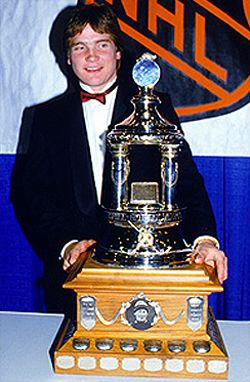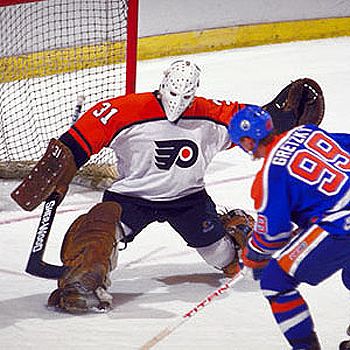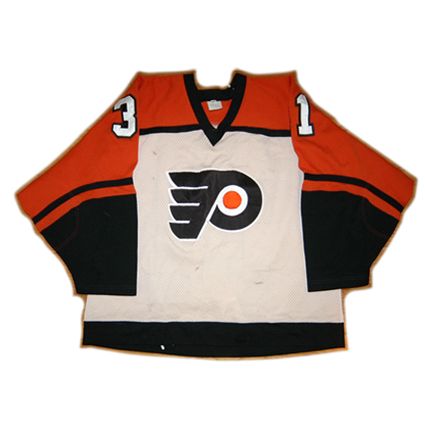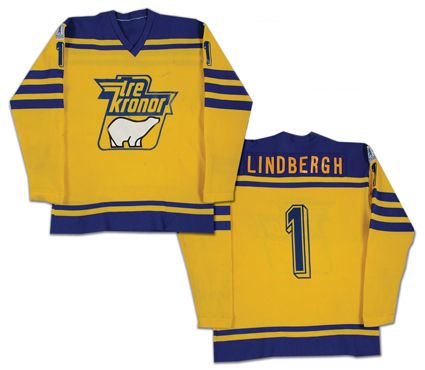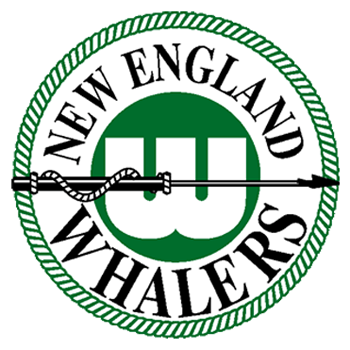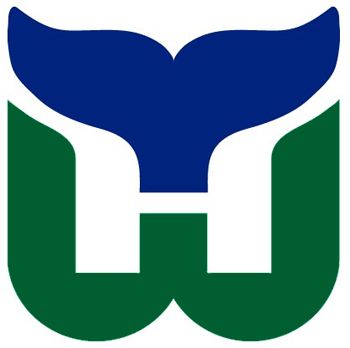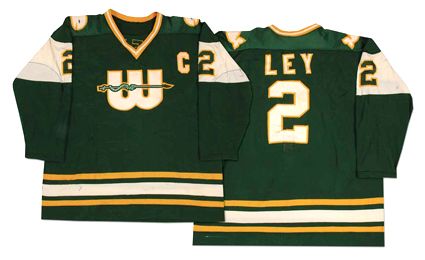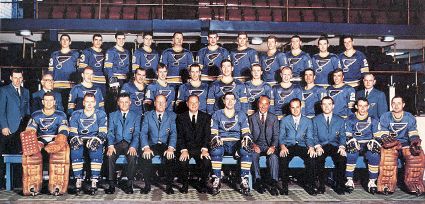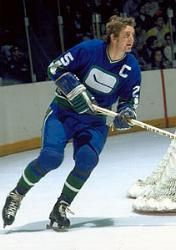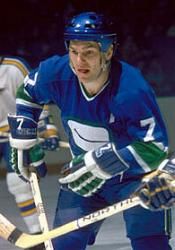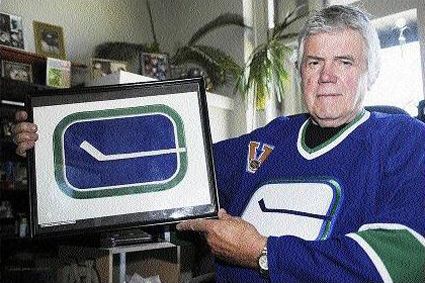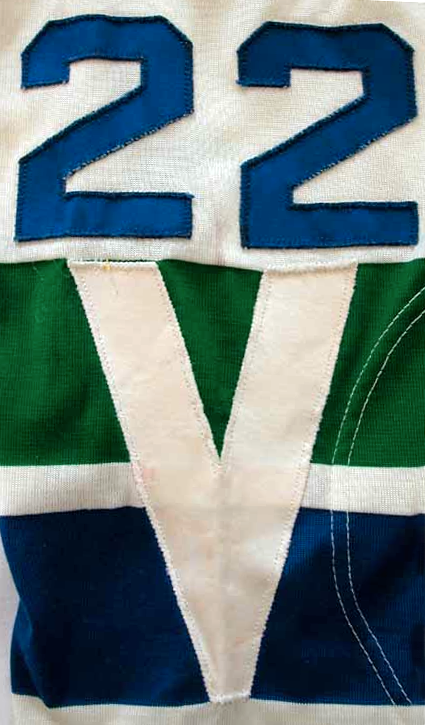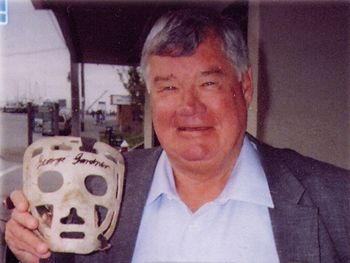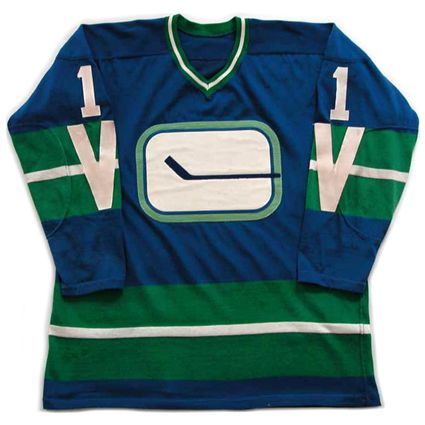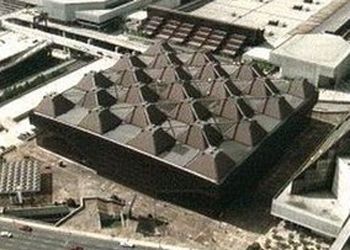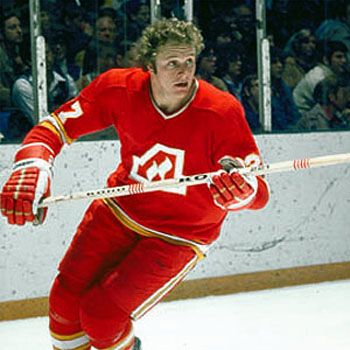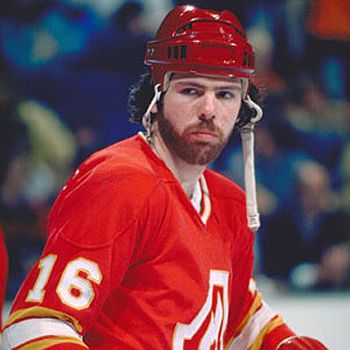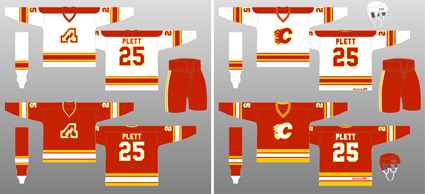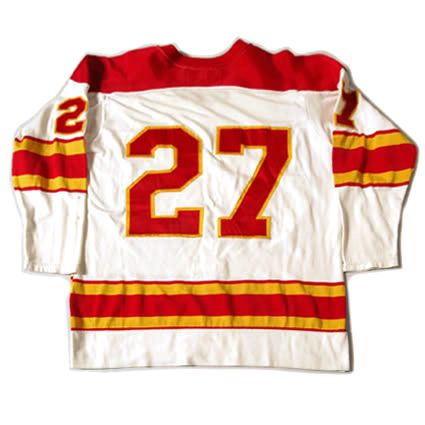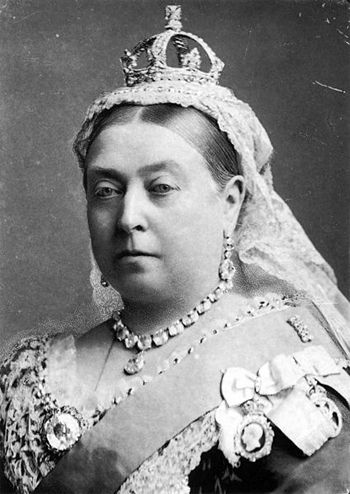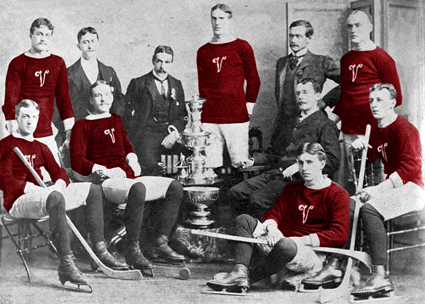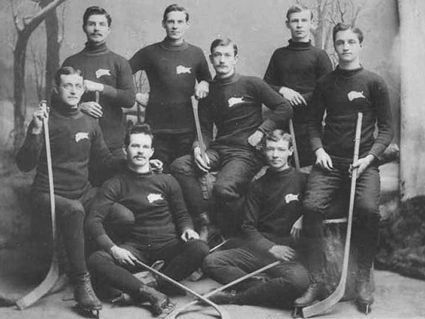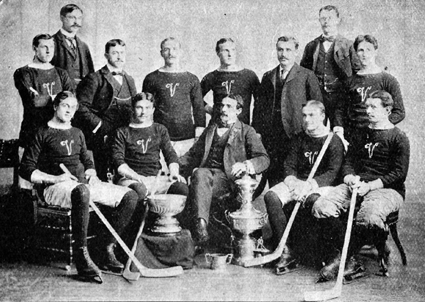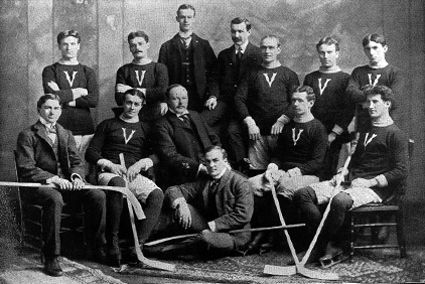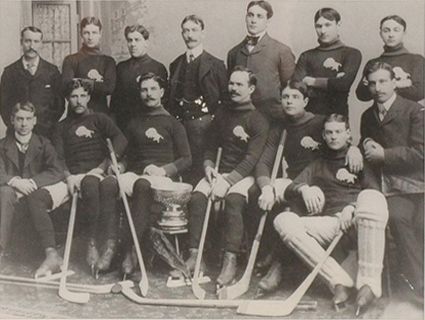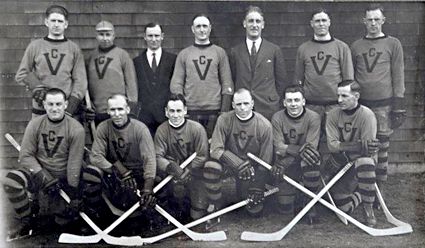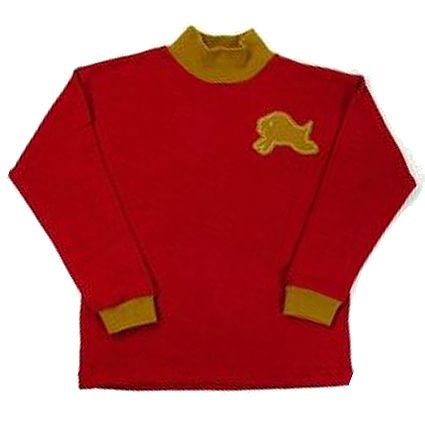Lindbergh was kept on life support long enough for his father to arrive from Sweden to join Lindbergh's mother, who was already in the United States on a visit, to say goodbye and then make the final decision to donate his organs and end life support on November 12th. Lindbergh was just 26 years old.
Friday, May 24, 2013
1984-85 Philadelphia Flyers Pelle Lindbergh Jersey
Born on this date in 1959 in Stockholm, Sweden Per-Eric "Pelle" Lindbergh made his debut with Hammarby IF of Stockholm's junior team in 1975 and made his international debut for the Sweden National Team that same season in the European Junior Championships earning the silver medal as well as the award for Best Goaltender. A second season with Hammarby as well as a second European Junior Championship appearance followed in 1976-77, which resulted in a gold medal as well as a second Best Goaltender award at the 1977 EJC.
Lindbergh in goal for Hammarby. Note the
Flyers logos on his mask even then.
His first season with Hammarby IF in Sweden's Division 1 in 1977-78 was highlighted with four games played at the newly promoted World Junior Championships, backstopping Sweden to a silver medal. At the time, NHL players had begun appearing in the World Championships, beginning in 1976. International Ice Hockey Federation officials began to fear that true amateur and younger players were losing their places they traditionally held with teams at the World Championships, so the Under-20 Junior Championships were elevated to full world championship status in 1977.
A second season with Hammarby IF in Division 1 in 1978-79 saw him named Best Goaltender at the 1979 World Junior Championships, where Sweden would win the bronze medal, followed by making his debut with the Sweden National Team at the senior level at that year's World Championships in Moscow, helping Sweden to a bronze medal finish. He was also drafted by the Philadelphia Flyers 35th overall in the 1979 NHL Entry Draft and the second goaltender and second European taken that year.
1979-80 was a breakthrough season for the young netminder, as he would take over the starting role in goal for AIK Stockholm in the Elitserien, Sweden's highest professional level, appearing in 32 games and being named to the 1980 Swedish Olympic Team. Lindbergh would appear in five of Sweden's seven games as Sweden won the bronze medal.
He would make his NHL debut with the Maine Mariners of the American Hockey League in 1980-81, winning the Hap Homes Award, the Les Cunningham Rookie of the Year Award and the Red Garrett Most Valuable Player Award honors after a stellar 31-14-5 record in the regular season and a 10-7 mark in the playoffs as Maine reached the Calder Cup Finals.
Prior to the next season, Lindbergh was named to the Sweden National Team's roster for the 1981 Canada Cup tournament. He would split time in 1981-82 between the Mariners (25 games) and make his NHL debut with the Flyers with eight games, posting a 2-4-2 record.
The departure of Pete Peeters for the Boston Bruins opened up more time for Lindbergh in 1982-83, as he became the number one goaltender for the Flyers, appearing in 40 games, posting a 23-13-3 record and was named to the NHL All-Rookie Team and played in his first NHL All-Star Game. Following the NHL season Lindbergh played in his second World Championships for Sweden and yet another medal, this time a bronze, his seventh international medal.
Lindbergh at his first NHL All-Star Game in 1983.
Bob Froese took the majority of the starts in Philadelphia in 1983-84 with 48 games played, with Lindbergh finishing with a 16-13-3 mark in 36 appearances.
The high point of Lindbergh's career came in the 1984-85 season, when Lindbergh saw the bulk of the workload, seeing action in 65 games while going 40-17-7 to lead the league in wins and help the Flyers reach the Stanley Cup Finals. His outstanding play was rewarded with his second NHL All-Star Game appearance as well as being named the recipient of the 1985 Vezina Trophy, the first European goaltender in NHL history to ever win the award.
Lindbergh with the Vezina Trophy.
Lindbergh also became the first goaltender to bring a water bottle with him on the ice during a game to combat severe dehydration that plagued him, a now accepted and regular practice.
In addition, Lindbergh was also known for his stark white goalie mask used during a period when nearly all goalie masks were adorned with increasingly elaborate paint schemes to reflect either the team's identity or their individual personality. The mask was a replica of his idol and goaltending coach, former Flyer goalie Bernie Parent.
Lindbergh facing The Great One, Wayne Gretzky
Following his Vezina Trophy winning season, Lindbergh signed a six year contract with the Flyers and bought himself a 565 horsepower, customized Porsche 930 Turbo. He began the 1985-86 season in good form, winning six of his first eight starts, but tragedy struck when Lindbergh crashed his car while driving impaired on November 10, 1985, leaving him brain-dead and his two passengers seriously injured.
Lindbergh was kept on life support long enough for his father to arrive from Sweden to join Lindbergh's mother, who was already in the United States on a visit, to say goodbye and then make the final decision to donate his organs and end life support on November 12th. Lindbergh was just 26 years old.
Lindbergh was kept on life support long enough for his father to arrive from Sweden to join Lindbergh's mother, who was already in the United States on a visit, to say goodbye and then make the final decision to donate his organs and end life support on November 12th. Lindbergh was just 26 years old.
His death stunned is teammates, the city of Philadelphia and the nation of Sweden. Fans then made Lindbergh the top vote getter for the 1986 NHL All-Star Game, the first time a player was chosen posthumously for an all-team in North American sports.
While Lindbergh's #31 was never officially retired, no Flyer has worn the number since.
The Flyers created the Pelle Lindbergh Memorial Award in 1994, given annually to the Most Improved Player each season.
For more on the life and career of Pelle Lindbergh, we recommend Pelle Lindbergh: Behind the White Mask .
.
Today's featured jersey is a 1984-85 Philadelphia Flyers Pelle Lindbergh jersey from the season he recorded his career high 40 wins. The Flyers adopted this modernized version of their classic jersey in 1982-83, Lindbergh's second season with Philadelphia. It featured the addition of more black trim to separate the orange arm coloring from the white of the body and was made by Sandow SK. The following season the jersey remained the same, but was now made by CCM. One season later the Flyers jerseys again were rebranded, this time by Eagle.
This style Flyers jersey was essentially carved in stone, as it remained unchanged through the 2006-07 season after which it was replaced by the Reebok Edge jersey, sadly doing in an iconic jersey after 20 years of service.
Bonus jersey: Today's bonus jersey is a 1979 Sweden National Team Pelle Lindbergh jersey as worn in the 1979 World Junior Tournament which took place in Sweden. Lindbergh was named the Best Goaltender and helped Sweden earn a bronze medal that year.
This jersey is from a period of time in the late 70's/early 80's when Sweden moved away from their traditional three crowns logo and instead sports the phrase "Tre Kronor", which translates to "Three Crowns".
While there are numerous Lindbergh game highlights, news reports and tributes available, we chose to feature this excellent tribute today.
Labels:
Lindbergh Pelle,
Philadelphia Flyers,
Sweden
Thursday, May 23, 2013
The New England Whalers Become the Hartford Whalers
Founded in 1972, the World Hockey Association began it's first season with an ambitious twelve member clubs located in Cleveland, Boston, New York, Ottawa, Philadelphia, Quebec, Edmonton, Chicago, Houston, Los Angeles, Minnesota and Winnipeg.
Team movement began before the second season had even begun, with Philadelphia relocating to Vancouver and Ottawa finding a new home in Toronto, while New York moved over to New Jersey and underwent a name change.
The third season saw expansion to Indianapolis and Phoenix, while the New Jersey franchise relocated cross-country to San Diego as Los Angeles moved to Detroit for just half a season prior to moving to Baltimore before folding for good after the season, as did Chicago.
And so it went for the next four seasons with additions such as Cincinnati and Denver, teams moving to Calgary, Ottawa again, Birmingham and Minnesota again, while clubs in San Diego, Phoenix, Calgary and Houtson folded after their seasons ended.
Worse, clubs were no longer waiting until the conclusion of the season to fold, as Ottawa, Minnesota (twice) and Indianapolis all called it quits mid-season.
Still, the four constants during all the franchise meandering and bankruptcies were the Edmonton Oilers, Quebec Nordiques, Winnipeg Jets and the New England Whalers, although in the interest of fairness it must be noted that the Whalers did relocate from Boston 91 miles up the freeway to Hartford, Connecticut midway though the 1974-75 season while keeping the "New England" moniker throughout.
The Whalers won the first WHA championship in 1973 and made the finals again in 1978. Finally after several years of negotiations and failed attempts, the Oilers, Jets, Nordiques and Whalers were granted expansion status into the NHL, leaving Birmingham and Cincinnati out in the cold. The original merger/expansion vote was initially rejected by a single vote but a massive boycott of Molson products in Edmonton, Winnipeg and Quebec City led to the Montreal Canadiens, who were owned by Molson at the time, and the Vancouver Canucks to change their votes during a second ballot, approving the plan on March 22, 1979.
One provision of the expansion, as the NHL chose to treat it, rather than a "merger", was the Boston Bruins insisting that the Whalers drop "New England" from their name. Thus, on this date in 1979, the New England Whalers formally changed their name to the Hartford Whalers.
The WHA teams were severely restricted by the terms of the deal. Since they were being treated as expansion clubs, they each were required to pay a $6 million franchise fee to enter the NHL, as well as returning any player who had left the NHL to join the WHA without compensation after being allowed to protect just two goalies and two skaters. They were also placed at the end of the line for the 1979 NHL Entry Draft, rather than having picks 1-4 as any normal expansion club would expect.
The Whalers chose to keep Jordy Douglas, Mark Howe and goaltender John Garrett. An agreement was also reached which allowed Gordie Howe to remain in Hartford despite the Detroit Red Wings legally having the right to reclaim the now 50 year old Howe.
The Whalers did lose Alan Hangsleben (Canucks), Rick Ley (Maple Leafs), George Lyle (Red Wings) and Warren Miller (Rangers) to their original clubs.
Once the reclaiming process was completed, an expansion draft was held, which allowed each NHL team to protect 15 skaters and two goalies before the "new" clubs were allowed to restock their rosters at a cost of $125,000 for each player chosen.
Thus, the Whalers paid $250,000 to simply keep Ley and Hangsleben on their roster in the end when they reclaimed the pair among the 16 players they selected at a cost of $2 million on top of the $6 million they had already been charged simply for the right to become a member of the NHL.
The move to the NHL resulted in an overhaul of the team's sweaters and logo. While the original team colors were simply green and white, gold trim was added for the second season while the crest was simplified to a "W" bisected by a harpoon. These jerseys would remain in use for three seasons before some striping changes to the road jerseys and the player's names changing from one color to two in 1976-77. The home jersey waist striping was changed to mirror that of the road jerseys in 1977-78 through the final WHA season of 1978-79.
On entry to the NHL, gold was dropped in favor of royal blue and a completely new jersey was designed to compliment the brand new, much more modernized team logo.
Today's featured jersey is a 1977-78 New England Whalers Rick Ley jersey. This was the third variation of road jerseys used by the Whalers while in the WHA and differed from the second version only in the waist stripes. No longer was it a wide white stripe with gold trim three stripe pattern, but now a main white stripe (thinner than previous) bordered with a pair of green stripes which were then in turn bordered by a pair of gold stripes in a five stripe "Northwestern" pattern as featured on today's jersey.
Ley played four seasons with the Toronto Maple Leafs prior to moving to the Whalers for their inaugural WHA season of 1972-73 through the demise of the WHA in 1979, being named team captain in 1975.
While Ley was reclaimed by the Maple Leafs as part of the expansion process, the Whalers reclaimed him from the Maple Leafs (for $125,000) and he played two more seasons with the renamed Hartford Whalers in the NHL, remaining team captain until 1980.
He would play 310 NHL games and 478 in the WHA with a combined 47 goals and 329 points plus 1244 penalty minutes. His #2 was one of only three numbers retired by the Whalers franchise.
Today's video section begins with Rick Ley scoring a shorthanded goal with speed and a nifty move for the Whalers.
Here Ley is later interviewed later on in the same game.
Here is a video scouting report on Ley with rare video clips from the Whalers very first season of 1972-73 using their original jerseys featuring the circle crest.
Our final clips today are the kind we just live for. First, the Whalers are introduced to the sounds of "Brass Bonanza" in an all-too-short clip, followed by game action from their December 27, 1976 Super Series meeting in which the New England Whalers defeated the Soviet National Team, with Vladislav Tretiak in goal, 5-2!
Labels:
Hartford Whalers,
Ley Rick,
New England Whalers,
WHA
Wednesday, May 22, 2013
1970-71 Vancouver Canucks Garth Rizzuto Jersey
Since the demise of the Brooklyn Americans in 1942, the NHL consisted of just six member teams, commonly referred to as "The Original Six". Finally, following the success of the Los Angeles Dodgers and San Francisco Giants in Major League Baseball on the west coast, the idea of expanding the NHL was first brought up in 1963, partly due to fears that the Western Hockey League was intending to operate as a major league in the near future and also in hopes of making the league more attractive to American television networks with coast-to-coast appeal.
Today's video section begins with a look at how designer Borovich came up with the original, classic Canucks logo and how it made a return for the team's 40th anniversary.
This second one is clearly from the first two seasons, and features Pat Quinn adding to his penalty minute total.
Unfortunately for Canucks fans, we found footage of the Bruins scoring their three goals in 20 seconds. You may get a good look at the Canucks jerseys as they tend to be standing around and watching according to the announcers.
The original discussions promoted San Francisco and Vancouver as acceptable locations with Los Angeles and St. Louis also as potential candidates in March of 1965.
In February of 1966, applications were received from groups from Los Angeles, Pittsburgh, Minnesota, Philadelphia, San Francisco, Baltimore, Buffalo and Vancouver.
In the end, franchises were awarded to Oakland (across the bay from San Francisco), Los Angeles, Minnesota, Philadelphia, Pittsburgh and... St. Louis!
The decision to exclude Vancouver caught many by surprise, especially those involved in the construction of the brand new Pacific Coliseum in Vancouver, and angered not only the locals, but all of Canada, since the six chosen cities were all in the United States. Various reasons emerged to explain the surprise inclusion of St. Louis, despite the fact there was no formal proposal from a group representing St. Louis!
Reportedly, Toronto and Montreal did not want to share Canadian TV revenues with a third club and support for expansion from Chicago was contingent on the creation of a team in St. Louis, which would result in the sale of the run-down St. Louis Arena, which just conveniently happened to be owned by the Chicago Black Hawks ownership group at the time...
Less than a year later the Oakland Seals franchise was having financial difficulties and an apparent deal was struck to move the club to Vancouver. The NHL however, did not want to see one of their brand new franchises moved so quickly and killed the deal. In exchange for avoiding a lawsuit, the NHL promised Vancouver a team in the next expansion, which occurred on this date in 1970, when Buffalo and Vancouver were granted entry into the NHL, at a cost of $6 million, three times the prices paid in the 1967 expansion.
The first order of business was selecting a name for the new Vancouver franchise, and they chose to retain the name Vancouver Canucks, which had been in use by the Vancouver club in the WHL from 1952 to 1970. The club's original colors of Blue, white and green were chosen to represent the water, the snow and the mountains which surround Vancouver.
During the Expansion Draft on June 9, 1970, the Canucks chose Gary Doak, a defenseman from the Boston Bruins. Their second choice was Orland Kurtenbach, a center from the New York Rangers who became the Canucks first team captain. After choosing Ray Cullen, the Canucks selected Pat Quinn, who would one day return to coach the Canucks.
Orland Kurtenbach
Two days later, the league held it's annual Amateur Draft. The Sabres famously won the spin of a wheel to win the right to select first, leaving the Canucks with the second choice, which they used on defenseman Dale Tallon, who would play in Vancouver for three seasons.
The rest of their draft was less than successful, with forgotten names such as defenseman Jim Hargreaves (66 total games with Vancouver), goalie Ed Dyck (49 games) plus Brent Taylor, Bill McFadden and Dave Gilmour, all of whom never skated in the NHL.
The Canucks played their first game on October 9, 1970 against the Los Angeles Kings, with former Vancouver Millionaires player (1912-1921), the 86-year-old Cyclone Taylor, in attendance. Barry Wilkins had the distinction of scoring the first goal in team history. The Canucks first victory arrived two days later, as they exacted a measure of revenge for their delay in getting into the NHL on the Toronto Maple Leafs with a 5-3 win.
The Canucks would play respectable hockey for the first three months of the season until Kurtenbach was sidelined with a knee injury in late December with the team at 13-18-3 at the time. They would win only one game in January and just three in February to find themselves at 18-37-6, with the low point being allowing three goals to Boston in just 20 seconds on February 25th. They finished out the season 6-11-2 after Kurtenbach's return for a final record of 24-16-8 for a sixth place finish in the tough East Division with five of the well established Original Six franchises as competition.
The team was led in scoring by Andre Boudrias, who had 25 goals and 41 assists for 66 points. Rosaire Paiement led the team in goals with 34, as well as penalty minutes with 152. In all, six Canucks had 20 goals or more, with Boudrais and Wayne Maki tied for second with 25 and Murray Hall, Kurtenbach and Mike Corrigan each with 21. Tallon broke the Bobby Orr's rookie record for assists by a defenseman with 42 while Charlie Hodge led the goaltenders with 15 wins.
Andre Boudrias
Today's featured jersey is a 1970-71 Vancouver Canucks Garth Rizzuto home jersey. Rizzuto played 37 games for the Canucks in 1970-71, scoring 3 goals and 7 points. He later played two seasons for the Winnipeg Jets of the WHA.
The Canucks original "stick in rink" logo was designed by a local designer Joe Borovich and used until 1978 before being dropped in favor of the highly controversial "Flying V" style.
The original logo made a return in 2003 as a shoulder patch on the home and road jerseys as well as on the front of the club's vintage jerseys, worn occasionally for two seasons prior to it becoming the third jersey for 2006-07.
After designing the logo, Borovich was then asked to be involved with the design of the club's original jerseys as well. The "V" on the sleeve stripes only lasted two seasons before being removed when the sleeve and waist stripes were redesigned.
Bonus Jersey: Today's bonus jersey is a 1970-71 Vancouver Canucks George Gardner jersey in the road blue version.
Gardner played 11 professional seasons as a goaltender with a variety of clubs, seeing action in 66 games with the Detroit Red Wings and Vancouver Canucks of the NHL and 79 games with the Los Angeles Sharks and Vancouver Blazers of the WHA in addition to six different minor league teams.
Gardner displaying his old goalie mask
Extra bonus Jersey: Today's extra bonus jersey is a 1970-71 Vancouver Canucks Charlie Hodge jersey from the Canucks first season's goaltending wins leader. Another road
blue version, this one shows the V's on the arms much more clearly.
1970-71 was the final season of Hodge's long professional career, which began back in 1953-54 and included over a decade with the Montreal Canadiens that resulted in six Stanley Cups, three NHL All-Star Games and two Vezina Trophies shared with Gump Worsley.
As the NHL expanded, Hodge moved on to play three seasons with the Oakland Seals and his final one with the expansion Canucks.
1970-71 was the final season of Hodge's long professional career, which began back in 1953-54 and included over a decade with the Montreal Canadiens that resulted in six Stanley Cups, three NHL All-Star Games and two Vezina Trophies shared with Gump Worsley.
As the NHL expanded, Hodge moved on to play three seasons with the Oakland Seals and his final one with the expansion Canucks.
Today's video section begins with a look at how designer Borovich came up with the original, classic Canucks logo and how it made a return for the team's 40th anniversary.
This second one is clearly from the first two seasons, and features Pat Quinn adding to his penalty minute total.
Unfortunately for Canucks fans, we found footage of the Bruins scoring their three goals in 20 seconds. You may get a good look at the Canucks jerseys as they tend to be standing around and watching according to the announcers.
Labels:
Gardner George,
Rizzuto Garth,
Vancouver Canucks
Tuesday, May 21, 2013
The Atlanta Flames Are Extinguished
It was announced on this date in 1980 that the Atlanta Flames had been sold to a group of Canadian business men who announced that the franchise would relocate to Calgary, Alberta.
The Flames began play in 1972 as the NHL reacted quickly to occupy the new Nassau Coliseum on Long Island with the New York Islanders in order to prevent the upstart World Hockey Association from moving into the arena. Needing a second team to balance the schedule, Atlanta was also awarded a franchise to occupy The Omni, another brand new arena located in Atlanta, Georgia.
The Flames began play in 1972 as the NHL reacted quickly to occupy the new Nassau Coliseum on Long Island with the New York Islanders in order to prevent the upstart World Hockey Association from moving into the arena. Needing a second team to balance the schedule, Atlanta was also awarded a franchise to occupy The Omni, another brand new arena located in Atlanta, Georgia.
The team was named the "Flames", which originated from the famous burning of Atlanta during the American Civil War.
The Omni seated 15,278 for hockey and was a innovative architectural design with an unusual roof, which looked like an egg crate from the air. It's exterior panels which were designed to rust over to seal themselves shut(!), making a solid structure which would last for decades. The only problem was that the panels never stopped rusting, which eventually created holes in the outer wall so large people were able to sneak into the building for free!
The Omni
The club began with a reasonable start for an expansion team, which included being over .500 as late as mid-January, but a late season swoon saw them finish out of the playoffs at 25-38-15.
Being the only club in the American southeast, the Flames were faced with a difficult travel schedule, as the NHL's divisional alignment at the time defied any geographic logic, as it was still based on the principal of having the Original 6 teams in the East, while the 1967 expansion clubs grouped in the "West".
The additions of Vancouver Canucks and Buffalo Sabres in 1970 and the Islanders and Flames in 1972 further muddied the picture, as Atlanta was grouped with Philadelphia, Pittsburgh, Chicago, Minnesota, St. Louis (closest at 556 miles away), Los Angeles and Oakland, while the "East" division was home to... Vancouver!
The additions of Vancouver Canucks and Buffalo Sabres in 1970 and the Islanders and Flames in 1972 further muddied the picture, as Atlanta was grouped with Philadelphia, Pittsburgh, Chicago, Minnesota, St. Louis (closest at 556 miles away), Los Angeles and Oakland, while the "East" division was home to... Vancouver!
The Flames qualified for the playoffs in their second season after a nine point improvement in the standings, although with a sub .500 record of 30-34-14. Highlights that season included the additions of Tom Lysiak who led the club in scoring as a rookie.
Tom Lysiak
While the club improved to a 34-31-15 mark, their 83 points were not enough to make the playoffs. Bright spots were the addition of Eric Vail, who set a club record with 39 goals on his way to the Calder Trophy, and conference realignment, which saw Atlanta now in the Patrick Division (with Philadelphia, the New York Rangers and New York Islanders) of the Campbell Conference (which also included St. Louis, Chicago, Minnesota, Kansas City and Vancouver).
Eric Vail
While the club qualified for the playoffs in 1975-76 and posted their first winning record of 35-33-12, they remained winless in the playoffs, losing 2 games to none in an abbreviated best-of-three series after being swept in four straight by Philadelphia in 1974. The first signs of trouble on the financial front began to surface when their average attendance dropped from a high of 14,162 in 1973-74 to 13,444 then down to 11,963.
The following season of 1976-77 saw the Flames finally win their first playoff game, but were still eliminated in Round 1 by the Kings 2 games to 1. At one point the team was in danger of missing it's payroll in December, and in an emergency campaign, leading city businesses made $750,000 in advance ticket purchases to help the club avoid bankruptcy.
The now familiar pattern began to repeat, as the 1977-78 Flames once more saw a drop in attendance down to 10,501 as they again won 34 games and were eliminated in the opening round of the playoffs in two straight games, this time at the hands of the Red Wings.
A franchise record 90 points in 1978-79 saw a bump in average tickets sold, up to 11,441, but the Maple Leafs took their turn bouncing the Flames from the postseason in the now customary two straight games. While Lysiak was traded to Chicago, Guy Chouinard provided the thrills with the only 50 goal season in Atlanta history.
The 1979-80 season proved to be the Flames last in Atlanta, and yet again it was a predictable season for the club, as they won 35 games, the fifth time in 8 seasons with 34 or 35 wins. They then ended their eight year run in Atlanta with their fifth consecutive (and sixth overall) first round playoff loss, this time 3 games to 1 in the new best-of-five format to the New York Rangers, giving the Flames a combined playoff record of 2-15 in six tries.
With falling ticket sales combined with a rapid rise in player costs, due to the competition for players between the NHL and WHA, the Flames also suffered from the lack of a major television deal.
When an offer to purchase the club came from Nelson Skalbania, former owner of both the Edmonton Oilers and Indianapolis Racers of the WHA, the Atlanta ownership group accepted the deal and Skalbania immediately moved the club to Calgary, Alberta and chose to keep the name "Flames", feeling it reminiscent of the iconic "gas flares" of the oil production industry in Alberta.
History repeated itself in Atlanta one day short of 31 years later when the news broke that the troubled Atlanta Thrashers franchise was sold to a group who then moved the Thrashers over the border to Winnipeg, Manitoba as the long desired replacement for the beloved Jets, who relocated to Phoenix in 1996.
Today's featured jersey is a 1978-79 Atlanta Flames Eric Vail jersey. Vail played more games in Atlanta Flames history than any other player, 469, joining the club for it's second season of 1973-74 through their sale and relocation seven seasons later. Vail also led the Flames in all-time goals with 174 and ranked second in points with 383, behind only Lysiak.
The Flames used the same jersey for each of their eight seasons in Atlanta and it remained intact after the relocation to Calgary, allowing for the obvious change in crest from the flaming A to the flaming C, all the way through the 1994-95 season, a 15 year run for this classic hockey template.
The Calgary Flames pay tribute to their past by using the original Atlanta Flames logo as the A worn to designate their alternate captains.
This jersey was worn without names on the back until 1977-78 when they became mandatory for all NHL jerseys.
Note the Philadelphia Flyers reverse nameplates. They had one set made up for TV games and wore them on both the white and orange jerseys, a look they have recently revived.
This next collection of mayhem features the Flames and the Maple Leafs from 1979.
Labels:
Atlanta Flames
Monday, May 20, 2013
Victoria Day
Today is Victoria Day in Canada, a holiday celebrated on the last Monday prior to May 25th, the birthday of Queen Victoria, who was born on May 24, 1819. The holiday informally symbolizes the beginning of summer and celebrations of her birthday date back to official recognition of the occasion on her 26th birthday in 1845 - prior to the official founding of Canada in 1867.
It's celebrated in all of the provinces and territories of Canada, save Quebec, which calls the date National Patriots Day and celebrates those who fought against the British colonial power of the province back in 1837.
Following the death of Queen Victoria in 1901, the celebration was formally given the name Victoria Day. Today, various cities will hold parades, with the largest being in Victoria, British Columbia. Fireworks displays are also common.
Queen Victoria became the Queen of the United Kingdom on June 20, 1837 at the age of just 18 when the third of her late father's three older brothers, King William IV, passed away at the age of 71 with none of the three brothers leaving any legitimate surviving children to inherit the throne ahead of her.
She married Prince Albert in 1840 and had nine children together. Her reign would last 63 years and seven months, during which time there were great changes in industrial, cultural, political, scientific and military changes in the United Kingdom, as well as great expansion of the British Empire - a time which came to be known as the Victorian Era.
Beloved in Canada, Victoria, British Columbia, Victoria Island in Nunavut, Regina, Saskatchewan, Victoria, Newfoundland, Victoriaville, Quebec and numerous hospitals, bridges, streets, parks and even Queen's University are named in her honor, as were any number of hockey teams (roughly 25).
The most successful of the hockey teams named in her honor include the second team to ever hold the Stanley Cup, the Montreal Victorias in 1895, however, despite the Victoria's having won the Amateur Hockey Aassociation of Canada championship in 1895 but were not originally awarded the cup, as the trustees of the cup has already accepted a challenge for the cup, still held by the Montreal Hockey Club, from Queen's University of Kingston, Ontario.
The Winnipeg Victorias would regain control of the Stanley Cup in late January of 1901, just nine days after Queen Victoria's passing. Winnipeg retained their grip on the trophy until March 17, 1902. They would attempt to regain the cup through a challenge in February of 1903, as would the Montreal Victorias a month later, but neither were successful.
The Ottawa Victorias challenged the Montreal Wanderers for the cup in 1908, as did the Moncton Victorias in 1912 when they met the Quebec Bulldogs, but both were turned away. The final games of the challenge era of the Stanley Cup again involved the name Victoria, but this team were the Victoria Aristocrats from the city of Victoria, BC, who fell to the Toronto Hockey Club in March of 1914.
From that point on the Stanley Cup became an annual competition between the champions of the top professional leagues that had emerged, the National Hockey Association and the Pacific Coast Hockey League. It would take 11 years under this arrangement, by which time the PCHL had been absorbed by the Western Canada Hockey League, for the name Victoria to once again appear on the Stanley Cup when the Victoria Cougars (the same franchise once known as the Aristocrats) would defeat the Montreal Canadiens 3 games to 1 in 1925. The Cougars would return to the finals again in 1926, only to lose to the Montreal Maroons in the final Stanley Cup playoff before the WHL folded.
The folding of the WHL led to a series of developments, which saw the Victoria Cougars cease to exist and their roster being transferred to a new expansion club, the Detroit Cougars of the 11-year-old National Hockey League, who became sole holder of the cup, ending the "Victoria Era" of the Stanley Cup.
Today's featured jersey is an 1895-96 Winnipeg Victorias jersey. This sweater with the buffalo logo was worn by the Winnipeg Victorias, which unusually had no imagery, such as a "V" or crown to even suggest the team name of Victorias. One can only imagine the reaction today if a team named after a queen was represented with an image of a buffalo!
This next video contains footage of the funeral of Queen Victoria and a brief overview of her reign as Queen.
It's celebrated in all of the provinces and territories of Canada, save Quebec, which calls the date National Patriots Day and celebrates those who fought against the British colonial power of the province back in 1837.
Following the death of Queen Victoria in 1901, the celebration was formally given the name Victoria Day. Today, various cities will hold parades, with the largest being in Victoria, British Columbia. Fireworks displays are also common.
Queen Victoria became the Queen of the United Kingdom on June 20, 1837 at the age of just 18 when the third of her late father's three older brothers, King William IV, passed away at the age of 71 with none of the three brothers leaving any legitimate surviving children to inherit the throne ahead of her.
Queen Victoria's coronation portrait
She married Prince Albert in 1840 and had nine children together. Her reign would last 63 years and seven months, during which time there were great changes in industrial, cultural, political, scientific and military changes in the United Kingdom, as well as great expansion of the British Empire - a time which came to be known as the Victorian Era.
Queen Victoria
Beloved in Canada, Victoria, British Columbia, Victoria Island in Nunavut, Regina, Saskatchewan, Victoria, Newfoundland, Victoriaville, Quebec and numerous hospitals, bridges, streets, parks and even Queen's University are named in her honor, as were any number of hockey teams (roughly 25).
The most successful of the hockey teams named in her honor include the second team to ever hold the Stanley Cup, the Montreal Victorias in 1895, however, despite the Victoria's having won the Amateur Hockey Aassociation of Canada championship in 1895 but were not originally awarded the cup, as the trustees of the cup has already accepted a challenge for the cup, still held by the Montreal Hockey Club, from Queen's University of Kingston, Ontario.
The trustees of the Stanley Cup, in a most unusual decision, decided that if the Montreal Hockey Club (also known as Montreal AAA) defeated Queen's University to defend the supremacy of the AHAC, the Victoria's, champions of the league that Montreal AAA belonged to, would be awarded the cup! The Montreal Hockey Club did win 5-1 and the Montreal Victorias became the second holders of the Stanley Cup for 1895.
The Montreal Victorias in 1895 with the Stanley Cup
won for them by the Montreal Hockey Club!
The AHAC champion Victorias were challenged by the Winnipeg Victorias of the Manitoba Hockey League during the Montreal Victorias AHAC season on February 14, 1896. The Winnipeg Victorias came away victorious in the battle of Victorias by a score of 2-0, led by goalie Whitey Merritt, the first goalie to ever wear leg pads.
Two weeks later the Winnipeg Victorias locked up the MHL season title to retain ownership of the cup and were immediately challenged by the Montreal Victorias when their regular season concluded with them repeating AHAC champions in early March.
The only problem was that no suitable ice could be found with spring now on hand and the Montreal Victorias challenge, while accepted by the trustees, was postponed until the following winter. When cold weather again arrived, before the start of the 1896-97 season, the Montreal Victorias challenge of the Winnipeg Victorias was scheduled for December of 1896 to be played at the Granite Rink in Winnipeg.
It was described at the time as the greatest sporting event in Winnipeg history, with fans paying as much as $12 for a seat while fans back in Montreal gathered for up to the minute reports via telegraph.
Things went well for the home team as Winnipeg led at halftime by a score of 4-2. Montreal fought back, and while Winnipeg was able to score again, the team from the east was able to tie the game at 5-5 before the 20 year old Ernie McLea, who had already scored twice for Montreal and with time winding down, fired his third goal of the game past Winnipeg goaltender Merritt to win the game in the closing seconds to regain the cup for the Montreal Victorias in what was called "the finest match ever played in Canada" when it was all over.
McLea's three goals were the first hat trick in Stanley Cup history.
The AHAC champions and Stanley Cup holders, the Montreal Victorias.
Note the diminutive size of the Stanley Cup during it's formative years when compared to the AHAC championship trophy next to it.
Graham Drinkwater and Mike Grant from the 1986 Stanley Cup champion Montreal Victorias would eventually be inducted into the Hockey Hall of Fame, both in 1950.
The Montreal Victorias would retain control of the cup until March of 1899, which included a defense of the cup against the Winnipeg Victorias in February of 1899, won by Montreal 5-3 in a two-game, total-goals series, the third and final time the two Victorias would meet head to head for the Stanley Cup, with Montreal prevailing twice, in 1896 and 1899.
The Montreal Victorias would retain control of the cup until March of 1899, which included a defense of the cup against the Winnipeg Victorias in February of 1899, won by Montreal 5-3 in a two-game, total-goals series, the third and final time the two Victorias would meet head to head for the Stanley Cup, with Montreal prevailing twice, in 1896 and 1899.
The 1898-99 Montreal Victorias - note the change in
font for the "V" on their sweaters from earlier
font for the "V" on their sweaters from earlier
The Winnipeg Victorias would regain control of the Stanley Cup in late January of 1901, just nine days after Queen Victoria's passing. Winnipeg retained their grip on the trophy until March 17, 1902. They would attempt to regain the cup through a challenge in February of 1903, as would the Montreal Victorias a month later, but neither were successful.
The 1901 Stanley Cup holders, the Winnipeg Victorias
The Ottawa Victorias challenged the Montreal Wanderers for the cup in 1908, as did the Moncton Victorias in 1912 when they met the Quebec Bulldogs, but both were turned away. The final games of the challenge era of the Stanley Cup again involved the name Victoria, but this team were the Victoria Aristocrats from the city of Victoria, BC, who fell to the Toronto Hockey Club in March of 1914.
From that point on the Stanley Cup became an annual competition between the champions of the top professional leagues that had emerged, the National Hockey Association and the Pacific Coast Hockey League. It would take 11 years under this arrangement, by which time the PCHL had been absorbed by the Western Canada Hockey League, for the name Victoria to once again appear on the Stanley Cup when the Victoria Cougars (the same franchise once known as the Aristocrats) would defeat the Montreal Canadiens 3 games to 1 in 1925. The Cougars would return to the finals again in 1926, only to lose to the Montreal Maroons in the final Stanley Cup playoff before the WHL folded.
The 1924-25 Stanley Cup champion Victoria Cougars
The folding of the WHL led to a series of developments, which saw the Victoria Cougars cease to exist and their roster being transferred to a new expansion club, the Detroit Cougars of the 11-year-old National Hockey League, who became sole holder of the cup, ending the "Victoria Era" of the Stanley Cup.
Today's featured jersey is an 1895-96 Winnipeg Victorias jersey. This sweater with the buffalo logo was worn by the Winnipeg Victorias, which unusually had no imagery, such as a "V" or crown to even suggest the team name of Victorias. One can only imagine the reaction today if a team named after a queen was represented with an image of a buffalo!
Today's bonus jersey is a 1896-97 Montreal Victorias jersey. The Victorias represented the Scottish population of Montreal and wore burgundy sweaters with a "V" logo in various fonts during their early days. Like many clubs in the late 1800's the Victorias were named after Queen Victoria of England.
Today's video is a look at the Winnipeg Victorias first championship and how it helped the Stanley Cup become known across all of Canada.
This next video contains footage of the funeral of Queen Victoria and a brief overview of her reign as Queen.
Labels:
Canada,
Montreal Victorias,
Victoria Day,
Winnipeg Victorias
Subscribe to:
Comments (Atom)


